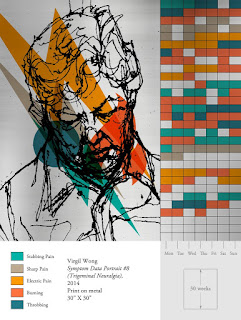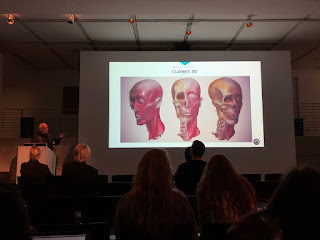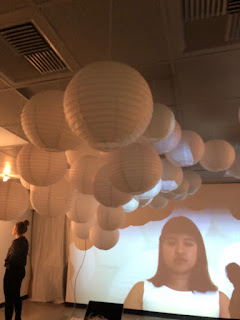Week 4
This week's material most interested me because it showed how the human body in its plainest form, inspired many works of art. For example, Drew Berry's Body Code highlighted the simplistic beauty of the human body at the molecular level. His work reminded me of when I was in high school and we dissected a strawberry to separate out the DNA to view under a microscope. We didn't get to view the strawberry DNA in the vivid coloring Berry's work displays it in, but I now understand just how beautiful DNA can be!
Virgil Wong's work also caught my eye due to his representations of pain. What made him chose the colors he chose? The shapes? What was striking in his work were his color tones; often times I think of pain as a blaring red color, but he incorporated cooler toned blues and greens into his work. In his piece Trigeminal Neuralgia, I was curious to see if the area with the most overlap with shapes meant anything. After a quick search on google of the disease, I learned that the pain primarily affects the jaw area, which was the area on the subjects face that had the most overlap. This piece is not only visually appealing, but it also portrays a medical condition in a way that makes sense to people who may not be in the medical field.
From the lecture, The Visible Human Project really interested me as this project had both medical and artistic applications. These cross-sectional photographs were used to create anatomy visualization applications, but also influenced many art and video projects, which again shows how the plain human body is not just for medical examination, but to create work that makes us think of the body in new ways. The versatile use of the Visible Human Project is as great example of this week's topic of the intersection between medical technologies and art.
Virgil Wong's work also caught my eye due to his representations of pain. What made him chose the colors he chose? The shapes? What was striking in his work were his color tones; often times I think of pain as a blaring red color, but he incorporated cooler toned blues and greens into his work. In his piece Trigeminal Neuralgia, I was curious to see if the area with the most overlap with shapes meant anything. After a quick search on google of the disease, I learned that the pain primarily affects the jaw area, which was the area on the subjects face that had the most overlap. This piece is not only visually appealing, but it also portrays a medical condition in a way that makes sense to people who may not be in the medical field.
 |
| Virgil Wong's Trigeminal Neuralgia |
 |
| Shoulders, a work of art from Lisa Nilsson that was inspired by the Visible Human Project. |
 |
| A virtual body model that is the basis of the interactive anatomical and radiological atlas VOXEL-MAN 3D Navigator: Inner Organs. |
Sources:
Berry, Drew. “Body Code.” Walter and Eliza Hall Institute of Medical Research, The Walter and Eliza Hall Institute of Medical Research, 12 Sept. 2017, www.wehi.edu.au/wehi-tv/body-code.
“The National Library of Medicine's Visible Human Project.” U.S. National Library of Medicine, National Institutes of Health, 10 Apr. 2018, www.nlm.nih.gov/research/visible/visible_human.html.
Nilsson, Lisa. “Tissue Series.” Lisa Nilsson, 2013, lisanilssonart.com/section/282102%20Tissue%20Series.html.
Wong, Virgil. “Corporeal Garden.” Virgil Wong, virgilwong.com/art/.
“Torso and Inner Organs of the Visible Human (2000).” Torso and Inner Organs of the Visible Human, www.voxel-man.com/gallery/visible-human/torso-and-inner-organs/.
“Torso and Inner Organs of the Visible Human (2000).” Torso and Inner Organs of the Visible Human, www.voxel-man.com/gallery/visible-human/torso-and-inner-organs/.



Your statement about the Trigeminal Neuralgia is definitely something that I also thought about while doing my assignment. It's weird the strange effects art, and specifically colors, can have on the way we feel and interpret things. I'd just like to add that it's amazing how you don't really notice how much ART is involved in all fields of study, even including medicine and anatomy. Without it, visualizations and ultimately our understanding of these fields, would not be possible.
ReplyDeleteIn our lectures, we focused only on the physical aspects of a human body, like bones structures and muscles. Therefore, I find it very interesting that you made connections between arts and human emotions as well. When we think of anger, we usually think of the color red. As for love, we think of a pinkish color. We also associate pain, anguish and sadness with cold colors like blue. My point is that there is such thing as color psychology where your mental state and emotions affect your perception of colors and vice versa. I just think it would be interesting to see the effects on MRI scans.
ReplyDelete